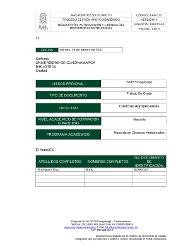| dc.description.abstract | La investigación evaluó 8 producciones agrícolas familiares en manejo convencional y en
transición agroecológica, ubicadas en el municipio de Silvania Cundinamarca, por un
muestreo aleatorio restringido para determinar la clasificación taxonómica de las arvenses
identificando las familias más abundantes sin discriminar por manejo productivo las cuales
fueron. Poaceae, Fabácea, Asterácea y Polygonaceae. Identificando un total de 1.626
individuos 22 ordenes, 26 familias y 53 especies, En el manejo en transición agroecológica
se identificaron un total de 25 familias con 51 especies, en comparación con el manejo
convencional en el que se identificaron 17 familias con 39 especies. De estas familias las
especies más abundantes que presentaron mayor relevancia en este manejo fueron;
Pennisetum clandestinum, Axonopus micay, Trifolium repens, Rumex crispus y Drymaria
cordata. La riqueza de los agroecosistemas fue mayor en los sistemas agrícolas en proceso
de transición agroecológica, Para el índice de riqueza Margalef fue estadísticamente más
alto en el manejo de transición agroecológica 8.91, en relación al manejo convencional
6.78. La diversidad de Shannon Wiener en los dos manejos productivos, presentaron
valores que denotan alta diversidad. Sin embargo, los sistemas agrícolas en transición
agroecológica presentaron mayor diversidad. De acuerdo a la información recopilada se
puede indicar, la presencia de arvenses en cultivos diversos es de importancia agrícola para
su manejo y conservación, Como producto de esta investigación se está elaborando una
cartilla que contendrá información sobre prácticas de conservación de las mismas que
reportará potenciales usos de algunas de las arvenses identificadas en este estudio.
The research evaluated 8 family agricultural productions in conventional management and
in agroecological transition, located in the municipality of Silvania Cundinamarca, by a
restricted random sampling to determine the taxonomic classification of the weeds,
identifying the most abundant families without discriminating by productive management
which they were. Poaceae, Fabacea, Asterácea and Polygonaceae. Identifying a total of
1,626 individuals, 22 orders, 26 families and 53 species, In the agroecological transition
management a total of 25 families with 51 species were identified, in comparison with the
conventional management in which 17 families with 39 species were identified. Of these
families, the most abundant species that presented the greatest relevance in this
management were; Pennisetum clandestinum, Axonopus micay, Trifolium repens, Rumex
crispus and Drymaria cordata. The richness of the agroecosystems was higher in the
agricultural systems in the process of agroecological transition. For the Margalef wealth
index it was statistically higher in the agroecological transition management 8.91, in relation
to the conventional management 6.78. The diversity of Shannon Wiener in the two productive
managements, presented values that denote high diversity. However, agricultural systems
in agroecological transition presented greater diversity. According to the information
collected, it can be indicated that the presence of weeds in various crops is of agricultural
importance for their management and conservation.As a result of this research, a booklet is
being prepared that will contain information on conservation practices that will report
potential uses of some of the weeds identified in this study. | es_CO |


